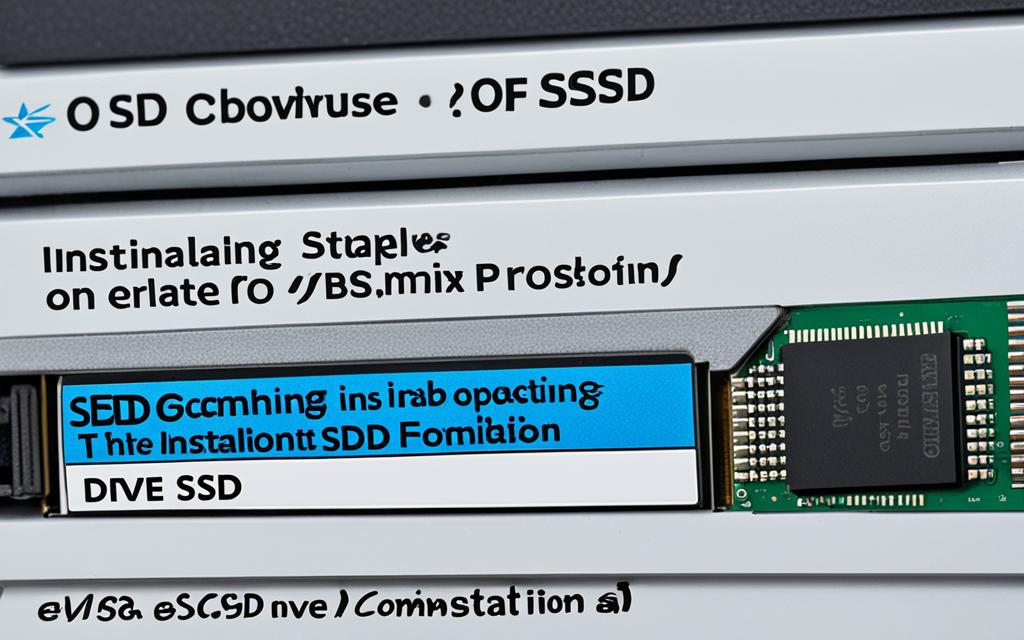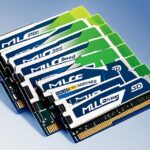Table of Contents
In today’s world, having good storage is key. Putting an operating system (OS) on a new solid-state drive (SSD) can make your computer work better. This guide will show you how to set up OS on SSDs, focusing on Windows 10 and 11. SSDs provide faster start times and are more reliable. This makes a big difference in performance.
By getting ready and learning how to add an OS to a new SSD, you can upgrade your system smoothly. Plus, with SSDs, changing operating systems takes just 25-30 minutes. This makes the process easy1. Follow our guide to start this upgrade.
Key Takeaways
- Understand the numerous benefits of SSDs over traditional HDDs.
- Familiarise yourself with system requirements for Windows 10 and 11 installations.
- Learn the step-by-step process for installing an OS on an SSD.
- Explore methods for preparing your new SSD to ensure optimal performance.
- Discover how to configure your SSD as the boot drive.
Why You Should Install an Operating System on an SSD
Putting your operating system on a Solid State Drive (SSD) can vastly improve how your computer works. Benefits of SSDs are not just speed but also include features for all kinds of needs. As technology grew, the gap in performance between SSD vs HDD got bigger. Now, SSDs are the top choice for lots of users.
Benefits of SSDs Compared to HDDs
SSDs stand out because they’re fast and powerful. They make your computer start up faster, load apps quicker, and respond more swiftly than hard disk drives (HDDs). A SSD can boost performance by over 60% compared to HDDs, making them worth the extra cost2. Meanwhile, HDDs are cheaper and can store more data. They’re good for backups thanks to their sturdiness2.
Why SSDs Enhance Computer Performance
The speed jump with SSDs can make a huge difference in how your computer runs. You’ll get into your system faster and handle big tasks like gaming and video editing better. The availability of tools like EaseUS Partition Master makes it easy to move from HDD to SSD. This move cuts down OS installation time a lot3.
Choosing an SSD boosts your computer’s current speed and improves battery life for portable devices. This makes them perfect for use anywhere.
Understanding SSD Technology
Learning about SSD technology is key for anyone wanting to boost their computer’s speed. SSDs are different from HDDs because they don’t have moving parts. This lack of movement helps SSDs work faster and start quicker, often making computers run more than twice as fast. This is why SSDs are seen as efficient4.
The Mechanics of SSDs
SSDs store data using NAND flash memory, which makes them durable and quick. Putting them in a computer is easy. You just connect two cables until they click. That’s why many people choose SSDs to make their computers run better.
Different Types of SSDs Available
It’s important to know the different SSDs when you’re picking one. Here are the usual types:
- 2.5 Inch SATA SSDs: These are almost twice as quick as old hard drives. They also cost less than M.2 drives.
- M.2 SSDs: They are up to four times faster than 2.5 Inch SATA SSDs. These are for tasks that need a lot of speed but are pricier.
- NVMe SSDs: These use the PCIe interface for the fastest speeds, great for demanding uses.
Knowing the differences in speed and how they connect helps in choosing the right SSD. Using an SSD as the main drive makes a computer much quicker. Some SSDs even get ten times faster with features like Momentum Cache5.
System Requirements for Installing Windows
To install Windows on your new SSD, you must understand the system requirements. Windows 10 and 11 each have their own requirements. These must be met for a smooth installation and good performance.
Minimum System Requirements for Windows 10/11
Windows 10 needs a processor with at least 1 GHz speed. You will also need a minimum of 1 GB of RAM for 32-bit versions. Or 2 GB for 64-bit6.
Windows 11 asks for more, like a compatible 64-bit processor. At least 4 GB of RAM and a minimum of 64 GB of disk space are needed for installation7. You also need a graphics card that supports DirectX 12 or later, and a TPM version 2.0.
Ensuring Compatibility for SSD Installation
Checking SSD compatibility is vital, especially for Windows 118. Make sure your hardware supports UEFI firmware. Also, ensure the SSD is set up in GPT partition format to avoid issues. Using tools like MiniTool Partition Wizard can make moving Windows to the SSD easier, without a full reinstall6.
How to Install Operating System on New SSD
There are two main ways to install an operating system on a new SSD. You can do a clean installation or use OS migration tools. Both ways work well, but knowing how to install Windows on an SSD properly can boost performance.
Step-by-Step Guide for Clean Installation
To start a clean installation, first prepare a USB drive with the Windows files. This method gets rid of unwanted software and enhances performance. Here are the steps:
- Make a bootable USB using the Media Creation Tool.
- Put in the SSD and plug in the USB drive.
- Enter BIOS and choose the USB as the top boot option.
- Adjust the partitioning options for the best SSD use.
A clean install makes your operating system feel brand new but might need you to switch disk formats if you hit installation errors910.
Using OS Migration Tools for Installation
If you want to keep your files and programs, OS migration tools are a great choice. Tools like AOMEI Backupper Professional let you copy your old Windows OS to a new SSD easily. Just follow these steps:
- Make sure your system sees the SSD.
- Install the OS migration software.
- Back up essential data first.
- Pick the SSD as the clone destination.
- Start the cloning operation.
This approach makes changing to a new SSD smooth, even for beginners. It also reduces the risk of losing data910.
Preparing Your New SSD for Installation
Getting your SSD ready for OS installation is crucial. You need to take a few steps to make sure everything works great. These include how to get the SSD ready and creating a strong backup of your data.
Initialising Your SSD Before Use
Initialising the SSD is the first step. You’ll use Disk Management in Windows for this. You can format it with MBR or GPT, depending on what your system needs. This makes your SSD ready for installation with the right format for your computer.
Backing Up Important Data
It’s vital to save your important data before switching to a new SSD. Accidental data loss is a real risk, so a good backup plan is a must. Use system images or external drives to keep your files safe. This step keeps your valuable data safe during the switch, allowing for an easy move to the new SSD.
By following these key steps, you’ll set yourself up for a smooth SSD setup. Plus, you’ll keep your data safe. Taking time to prepare means a lot easier installation later on1112.
Configuring the SSD as Your Boot Drive
Once you’ve installed the OS on your SSD, the next step is to set it as the boot drive. This is key to making your computer work faster. Just follow a few easy steps to do this.
Accessing BIOS to Change Boot Order
You need to enter the BIOS when you start up the computer to set the SSD as your boot drive. Press F2 or Delete right after you turn the computer on. Once you’re in the BIOS menu, there’s an option to change BIOS boot order. Make sure the SSD is the first boot device. This way, your system will start from the SSD, boosting your computer’s speed and performance.
Troubleshooting Boot Issues After Installation
Sometimes, you might face boot problems even after setting up everything. If this happens, check the BIOS settings again. Make sure the BIOS recognizes the SSD. Issues might arise from wrong partition setups or missing files. Ensure the SSD’s space is not bigger than the system disk’s to avoid problems.
Using tools like EaseUS Partition Master and Macrium Reflect helps ensure a successful move to SSD. Remember to back up important data on the SSD to avoid losing it. A careful and organized process is crucial for positive results in setting up your SSD1314.
Conclusion
Taking the step to put a new operating system on your SSD is a smart move. It makes your computer faster and more reliable. As a result, you’ll get a better experience and see an improvement in how your computer works.
By following the steps to install the OS on SSD, you make sure the process goes without a hitch. SSDs are much quicker than old hard drives. They’re also tougher and can take a knock because they don’t have any moving parts15.
Following this guide means you’re on track for top-notch system performance. It’s something you can do and will be glad you did. A fresh install makes the best use of your SSD. You’ll enjoy quick start-ups and smoother running. It’s definitely a smart investment16.
FAQ
What is an SSD and how does it differ from an HDD?
An SSD, or solid-state drive, is a type of storage that uses flash memory. It’s faster and more reliable than HDDs, which use spinning disks to read and write data.
Can I install Windows 10 or 11 on any type of SSD?
Yes, you can install Windows 10 and 11 on various SSDs. But, SSDs using the NVMe protocol need a motherboard with M.2 slots. SATA SSDs work with many systems.
What are the minimum system requirements to install Windows 10 and Windows 11?
For Windows 10, you need a 1 GHz processor and at least 1 GB RAM for 32-bit, or 2 GB for 64-bit systems.
Windows 11 requires a compatible 64-bit processor, at least 4 GB RAM, TPM version 2.0, and UEFI firmware.
How do I prepare my SSD for a clean installation of Windows?
Start by initialising the SSD through Disk Management. Then, back up any important data to avoid losing it during the install.
What tools can I use for OS migration to a new SSD?
You can use tools like EaseUS Partition Master and Macrium Reflect for OS migration. They let you transfer your Windows system to a new SSD easily.
Can I install Windows 10 or 11 on any type of SSD?
Yes, you can install Windows 10 and 11 on various SSDs. But, SSDs using the NVMe protocol need a motherboard with M.2 slots. SATA SSDs work with many systems.
How do I configure my SSD as the primary boot drive?
Access the BIOS settings when you start up by pressing F2 or Delete. Then, change the boot order so the SSD is first for startup.
What should I do if I encounter boot issues after installing the OS on my SSD?
If you have boot problems, make sure the BIOS detects the SSD correctly. Also, check for wrong partition schemes and intact system files for a smooth boot.
Source Links
- https://www.easeus.com/partition-master/install-windows-10-on-ssd.html – How to Install Windows on SSD via 2 Easy Ways 🏆
- https://www.easeus.com/partition-manager-software/install-os-on-ssd-everything-else-on-hdd.html – How to Install Operating System on SSD and Everything Else on HDD
- https://www.wps.com/blog/how-to-install-windows-1011-on-new-solid-state-drive-ssd-in-easy-steps/ – How to Install Windows 10/11 on New Solid State Drive(SSD)? (In Easy Steps) | WPS Office Blog
- https://www.cdw.com/content/cdw/en/articles/hardware/how-to-install-an-ssd.html – How to Install an SSD
- https://www.crucial.com/articles/about-ssd/how-to-install-ssd-in-laptop – How to Install an SSD in a Laptop
- https://www.partitionwizard.com/partitionmanager/install-windows-10.html – How to Install Windows 10 on a New Hard Drive (with Pictures) – MiniTool Partition Wizard
- https://learn.microsoft.com/en-us/windows/whats-new/windows-11-requirements – Windows 11 requirements
- https://www.diskpart.com/windows-11/install-windows-11-on-ssd-0725.html – 2024 Full-guide: Install Windows 11 on SSD (OS on HDD)
- https://www.diskpart.com/windows-10/install-windows-10-on-ssd-4348.html – How to Install Windows 10 on SSD Easily and Successfully
- https://www.ubackup.com/windows-10/install-windows-10-to-ssd.html – Directly Install Windows 10 on New SSD with/without CD | 2 Ways
- https://www.easeus.com/partition-master/install-a-new-hard-drive-or-ssd.html – Beginner’s Guide – Install A New Hard Drive/SSD in Windows 10/8/7
- https://www.pcmag.com/how-to/copy-your-windows-installation-to-an-ssd – How to Copy Your Windows Installation to an SSD
- https://www.easeus.com/partition-master/set-ssd-as-boot-drive.html – How to Set SSD as Boot Drive [2024 Updated]
- https://www.xda-developers.com/how-turn-ssd-boot-drive/ – How to turn your SSD into a boot drive for your new or existing computer
- https://www.diskpart.com/articles/how-to-install-windows-on-new-ssd-laptop-1503.html – How to Install Windows on New SSD Laptop [Easy Guide]
- https://www.bogleheads.org/forum/viewtopic.php?t=392843 – How to install Windows on a new blank SSD disk?








